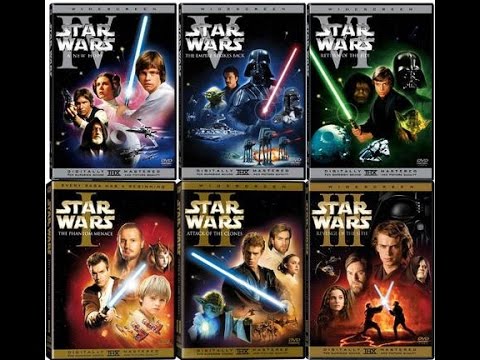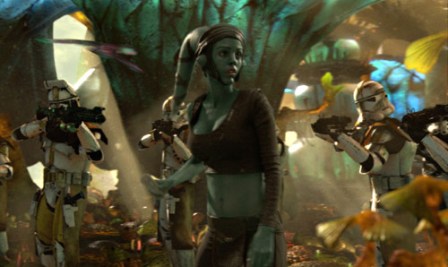Welcome, dear readers, as we continue our slow-motion review of Star Wars IX: The Rise of Skywalker.

As we said in our last, we thought that it might be useful, and we hope, interesting, to review it by seeing it as we imagine the creators did, as the final installment of something which began almost as “long ago” as that well-known subtitle says the story took place.
We begin with the idea of trilogies.
In Western story-telling, three is a kind of magic number—almost an embodiment of the English proverb, “Third time pays for all”, where the third of three things completes something. Fairy tales, for instance often involve three wishes. Sometimes that third wish is a corrective, when the first two take the story in a bad direction. In the story of “The Fisherman’s wife”, one of the tales in the Grimm Brothers’ collection of German fairy tales, the greedy fisherman’s wife even asks for a fourth wish–and loses everything the first three have given her. (If you don’t know this story, here’s a LINK to the 1868 edition of the first English translation (1823) of it, by Edgar Taylor: https://ia600907.us.archive.org/12/items/germanpopularsto01grim/germanpopularsto01grim.pdf).
When we think of books written to be read in a three, we might think of Suzanne Collins’ Hunger Games,

or Philip Pullman’s His Dark Materials

(if you’ve read these in the US, you’ll know that first volume, Northern Lights, by another title, The Golden Compass)
or, of course, Tolkien’s The Lord of the Rings

(although it was never designed to be such—early 1950s British printing demands broke what was thought of as a single work into three).
In the case of Star Wars, however, there is not one trilogy, but three.

(actually 2 and 2/3s—IX is not yet commercially available, but here it is for completeness).

Reading about the problems the original director/main writer, George Lucas,

faced in gradually developing the story, we learn that, for a time, his plans kept changing until he finally settled on beginning the big story not with I, but with IV.

Instead of returning to I after that, however, he went on to make his first trilogy of IV, V, and VI.

Ultimately, the two main characters of this trilogy are Luke Skywalker and his antagonist, Darth Vader.

In this second trilogy—although really the first in the series—Lucas had set his audiences what seemed to be several puzzles:
- who was Darth Vader—and why/how does he turn out to be (no spoiler alert here, we’re pretty sure!) Luke’s father? (and, we’d add, “Who’s his mother?”)
- what is the more general context—among other things, there’s talk of a republic and its senate, of “Jedi”, and then of the galaxy being ruled by an evil emperor who, when we see him, employs powers he derives from the “dark side” of “The Force”—so where does all of this come from?
And so, in this first trilogy (shown here with the second, as images of the first trilogy seem hard to find),

not only has the author given us several puzzles, but he’s seemingly set himself what might prove to be a very difficult task. If he tells the story of Darth Vader in the first set of three films, Vader has already appeared as such a monster that it might be impossible to generate any sympathy for him, making him simply a two-dimensional villain of the sort the emperor appears to be in the second trilogy, and any films in which he is a main, if not the main, character, could be mostly just a series of repetitions of his evil behavior. Instead, Star Wars I

begins with two of those Jedi, a master (as he’s called by the other), and an apprentice (called a “padawan”), Qui-Gon and Obi-Wan.

During their adventures, they encounter the Queen of Naboo, Padme,

and what appears to be a kind of child prodigy, Anakin.

Qui-Gon decides that Anakin is something called “the Chosen One”, who is to “bring balance to the Force” and proposes to adopt him as his next padawan/apprentice. The difficulty with this, as we are told in time, is that Jedi:
- must be without fear or anger
- must renounce all attachments
Anakin, still a little boy, must leave his mother, Shmi (short for Lakshmi, after the Hindu goddess of good fortune?)

and is obviously troubled about this: a possible serious flaw in his becoming a Jedi, let alone “the Chosen One”.
Qui-Gon is killed in a duel with a mysterious figure called “Darth Maul”,

who is, in turn, cut in two by Obi-Wan,

and, at the conclusion of this first film, Obi-Wan, now a Jedi himself, pledges to become Anakin’s master,

much against the will of a senior Jedi, Yoda, who has examined the boy and seen very clearly that flaw, along with his possibilities.

So far, then, the story is about promise, that Anakin will grow into a Jedi, but also a threat: will Yoda’s doubts be proved correct? And who was Darth Maul and why was he despatched on what looks like an assassination attempt? We are briefly told that he was a “Sith” and the equivalent of a padawan, with the addition that, where there is one Sith, there is always one more…
The second film, Attack of the Clones,

seems to take place about 10 years later: Obi-Wan is now a settled Jedi (with a beard) and Anakin is a sort of senior apprentice, who nurses a growing sense of resentment that he’s never recognized as he believes he should be for his abilities.

At this point, Padme, now a member of the Galactic Senate, reappears,

having just survived an assassination attempt. Anakin confesses his attraction for her and, added to his anger, we see the very beginnings of what Yoda has always feared.

This is only intensified when Anakin discovers that his mother has been captured on his home planet of Tatooine by Sand People and, basically, tortured to death.

Beyond the personal, we see that the Republic is falling apart: a number of planetary systems within the Galaxy are struggling to separate themselves. The current Supreme Chancellor is forced to step down and, in his place, another senator from Naboo, Palpatine, is his replacement. We saw Palpatine briefly in the first film and we see him again here and he seems like a sympathetic, if minor, figure. Fatherless himself, and increasingly estranged from Obi-Wan, Anakin is drawn to him.
By the end of the second film, developments have come in quick succession: the rebellion of the Separatists is being fueled by a one-time Jedi, Count Dooku; to defend itself, the remaining members of the Senate vote to form an army—only to find that there already is one, an army of clones; and Padme has fallen in love with Anakin and they secretly marry.

We now come to the last of this first trilogy with Revenge of the Sith.

In a way, the title says it all: Senator Palpatine is revealed as the Sith lord, Darth Sidious, and Anakin, corrupted by his fears for Padme’s death in childbirth and Sidious’ suggestion that, as a Sith, he knows ways to deal with death, joins him as his apprentice, Darth Vader, as Sidious activates Order 66. It seems that, behind that mysterious clone army is Sidious himself, who has also been behind the Separatists, all to overthrow the Republic and become Galactic emperor. This, however, is only one of two goals. The other is the complete destruction of the Jedi order and Order 66 is the command, implanted in the clones, to murder all of the Jedi without question.


This then leads to the climactic battle between Obi-Wan and Anakin/Darth Vader,

in which Obi-Wan reluctantly defends himself but eventually defeats Anakin, who is left sprawled and mutilated, while Obi-Wan escapes with Padme, whom a jealous Anakin has nearly murdered. She dies, however, just as Anakin feared, in childbirth, leaving behind twins, Luke and Leia, who, to protect them from the murderous Darth Sidious, are to be raised on separate planets, Leia on Alderan and Luke on Tatooine.

Meanwhile, the dying Anakin is rescued by Sidious and reconstructed within the black armor in which we know Darth Vader, Sidious assuring him that he has killed Padme in his rage.

Yoda and Obi-Wan, two of the very few surviving Jedi, both disappear into exile, and we are left with the image of baby Luke in the arms of his foster parents, Beru and Owen, initiating a scene we will view again in the first film of the second trilogy.

So, in the three films of this first trilogy, we see:
- the fall of the Republic and the rise of the Sith Darth Sidious as Galactic emperor
- the destruction of the Jedi, with two notable exceptions
- the failure of Anakin as “the Chosen One” and his rebirth as the apprentice of the greatest enemy of the Jedi
- and yet we also see Anakin’s children, who will reappear in the fourth film, perhaps optimistically titled A New Hope?
We shall see in our next, even as we thank you for reading this posting, with a promise, rather than a hope, that
MTCIDC
CD